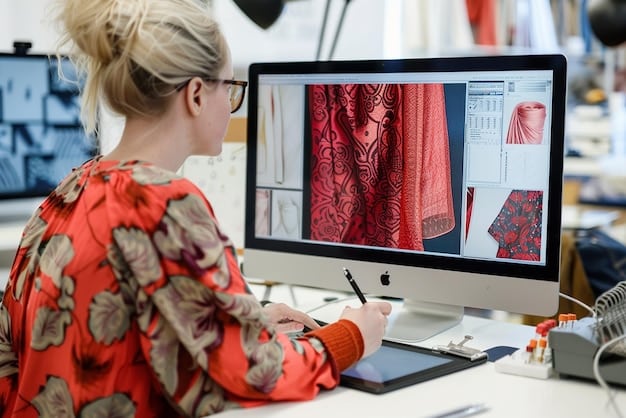Digital Fashion: Is It the Future of Self-Expression in the US?

Digital fashion, encompassing virtual clothes and accessories, is rapidly evolving in the US, offering new avenues for self-expression, identity exploration, and sustainable consumption within the digital realm.
Are virtual clothes the next big thing in expressing yourself? In the US, digital fashion is gaining traction, blurring the lines between physical and virtual identities.
The Rise of Digital Fashion in the US
Digital fashion is not just a trend; it’s a paradigm shift in how we perceive and interact with clothing. In the United States, this movement is gaining momentum, driven by a generation that values digital identity as much as, if not more than, physical appearance.
From virtual try-ons to entirely digital outfits, the US market is seeing an influx of innovative platforms and designers who are catering to this growing demand. What are the driving forces behind this surge in popularity?
Accessibility and Inclusivity
One of the key factors fueling the rise of digital fashion is its accessibility. Unlike traditional fashion, which often carries hefty price tags and exclusivity, digital clothing can be more affordable and inclusive.
Virtual garments can be “worn” on social media platforms or in virtual worlds, allowing individuals to express themselves without the financial barriers of physical couture. This democratization of fashion is particularly appealing to younger demographics in the US.
Environmental Concerns and Sustainability
Sustainability is another major driver. The fast fashion industry’s environmental impact is well-documented, leading many consumers to seek alternatives. Digital fashion offers a solution by eliminating the need for physical production, reducing waste, and lowering carbon footprints.
US consumers are increasingly aware of these issues, and digital fashion presents an attractive option for expressing their style in a more environmentally responsible way.

In conclusion, the rise of digital fashion in the US is driven by its accessibility, inclusivity, and sustainable nature. As technology evolves and consumer attitudes shift, virtual clothing is poised to become an integral part of self-expression.
Platforms and Designers Leading the Charge
The digital fashion landscape in the US is teeming with innovative platforms and visionary designers. These pioneers are pushing the boundaries of what’s possible, creating new ways for individuals to express their identity in the virtual world.
Several platforms and designers have emerged as leaders in this space. Who are they, and what are they doing to revolutionize the fashion industry?
DRESSX
DRESSX is a platform that offers a wide range of digital clothing from various designers. Users can purchase virtual garments and have them digitally “worn” on their photos or avatars.
This platform has gained significant traction in the US market for its seamless integration with social media and its diverse selection of styles.
The Fabricant
The Fabricant is a digital fashion house that creates exclusively digital clothing. Their designs are often avant-garde and experimental, pushing the boundaries of what fashion can be.
They collaborate with brands and individuals to create unique virtual garments that can be used in various digital contexts.
- RTFKT Studios: Known for their virtual sneakers and collectibles, RTFKT Studios merges fashion with gaming and blockchain technology.
- Tribute Brand: This brand focuses on contactless cyber fashion, allowing users to “wear” their designs through augmented reality.
- Republic Realm: An investment firm that also develops and invests in virtual real estate, NFTs, and digital fashion.
In conclusion, platforms like DRESSX and The Fabricant, along with other innovative designers, are spearheading the digital fashion revolution in the US, offering consumers unprecedented opportunities for self-expression and creativity.
How Digital Fashion Impacts Self-Expression
Digital fashion’s impact on self-expression is profound, offering individuals new ways to explore their identity and communicate their personal style. In the US, where individuality is highly valued, this aspect of digital fashion is particularly appealing.
How does digital fashion empower individuals to express themselves in ways that traditional fashion cannot?
Breaking Boundaries and Experimentation
Digital fashion allows for experimentation without the constraints of physical limitations. Users can try on outrageous or unconventional styles without the commitment or judgment often associated with real-world fashion choices.
This freedom fosters creativity and encourages individuals to explore different facets of their personality.
Customization and Personalization
Many digital fashion platforms offer customization options, allowing users to tailor garments to their specific preferences. This level of personalization enables individuals to create truly unique looks that reflect their individual style.
From changing colors and textures to adding embellishments, the possibilities are endless.

The ability to experiment and personalize virtual clothing empowers individuals to express themselves in ways that were previously unachievable. Digital fashion transcends the limitations of the physical world, offering a canvas for boundless creativity.
In conclusion, digital fashion provides a powerful tool for self-expression, allowing individuals to break boundaries, experiment with different styles, and create personalized looks that truly reflect their unique identity.
The Role of Social Media and Virtual Worlds
Social media and virtual worlds play a crucial role in the adoption and popularization of digital fashion. These platforms provide the stage for individuals to showcase their virtual outfits and engage with digital fashion communities.
How do social media and virtual worlds contribute to the growth of digital fashion in the US?
Virtual Influencers and Fashion Shows
Virtual influencers, such as Lil Miquela, have become prominent figures in the fashion industry, showcasing digital clothing and collaborating with major brands. These influencers have a significant impact on consumer trends and preferences.
Virtual fashion shows are also gaining popularity, offering a platform for designers to showcase their creations to a global audience.
Gamification and Virtual Avatars
Many video games and virtual worlds, such as Fortnite and Roblox, offer players the opportunity to customize their avatars with digital clothing and accessories. This gamification of fashion has introduced digital clothing to a wider audience.
Players can express their style and personality through their avatars, further blurring the lines between the physical and virtual realms.
Social media and virtual worlds provide the perfect environment for digital fashion to thrive. They offer a platform for showcasing virtual outfits, engaging with communities, and exploring digital identities.
- Digital Collectibles: Social media platforms are becoming marketplaces for digital collectibles, including fashion items, creating new revenue streams for designers and influencers.
- AR Filters: Augmented reality filters on platforms like Snapchat and Instagram enable users to “try on” digital clothing virtually, driving engagement and awareness.
In conclusion, the integration of social media and virtual worlds is essential for the continued growth and adoption of digital fashion in the US, providing a space for expression, community, and innovation.
Challenges and Obstacles in the Digital Fashion Realm
Despite its immense potential, digital fashion faces several challenges and obstacles that need to be addressed for it to reach its full potential. In the US, these challenges range from technological limitations to consumer adoption rates.
What are the main challenges and obstacles hindering the growth of digital fashion?
Technological Limitations
Current technology is not always capable of rendering digital clothing in a realistic and seamless manner. Issues such as clipping, poor textures, and unnatural movements can detract from the overall experience.
As technology advances, these limitations will likely diminish, but they currently pose a challenge.
Consumer Adoption and Skepticism
Some consumers are skeptical of the value of digital clothing, questioning the idea of paying for something that cannot be physically worn. Overcoming this skepticism requires educating consumers on the benefits and unique aspects of digital fashion.
Building trust and demonstrating the value proposition of virtual garments is crucial for widespread adoption.
Addressing these challenges is essential for the continued growth and development of digital fashion. Overcoming technological limitations and building consumer trust will pave the way for a more widespread adoption of virtual clothing.
Moreover, legal frameworks surrounding digital ownership and intellectual property rights need to be established to protect designers and consumers.
In conclusion, while digital fashion offers tremendous opportunities, it also faces significant challenges that must be addressed to ensure its long-term success.
The Future of Digital Fashion in the US
The future of digital fashion in the US is bright, with many predicting that it will become an integral part of the fashion industry. As technology continues to advance and consumer attitudes evolve, virtual clothing is likely to play an increasingly significant role in self-expression, commerce, and sustainability.
What trends and developments can we expect to see in the coming years?
Augmented Reality (AR) and Virtual Reality (VR) Integration
The integration of AR and VR technologies will further enhance the digital fashion experience, allowing users to “try on” virtual clothing in a more realistic and immersive manner. This technology will bridge the gap between the physical and virtual worlds.
Imagine being able to see how a virtual garment looks on your body in real-time, using your smartphone or a VR headset.
Blockchain Technology and NFTs
Blockchain technology and NFTs (non-fungible tokens) will play a crucial role in establishing ownership and authenticity in the digital fashion space. NFTs can represent unique virtual garments, ensuring their scarcity and value.
This will create new opportunities for designers to monetize their creations and for consumers to collect and trade virtual fashion items.
The future of digital fashion is full of possibilities. From AR and VR integration to the use of blockchain technology, the industry is poised for significant growth and innovation.
As virtual worlds become more immersive and social media platforms embrace digital fashion, we can expect to see virtual clothing become an increasingly important part of our lives.
In conclusion, digital fashion in the US is on the cusp of a major transformation, driven by technological advancements, changing consumer attitudes, and the increasing importance of digital identity. The future looks bright for virtual clothing as it becomes an integral part of self-expression and the fashion industry as a whole.
| Key Point | Brief Description |
|---|---|
| 🌍 Sustainability | Reduces environmental impact compared to physical fashion. |
| 🎉 Self-Expression | Offers limitless ways to express individual style virtually. |
| 🛍️ Accessibility | More affordable options for expressing style. |
| 🚀 Innovation | Driven by advancements in AR, VR, and blockchain tech. |
FAQ
Digital fashion refers to clothing and accessories that exist only in the digital realm. They are designed to be “worn” on photos, avatars, or in virtual environments, often through augmented reality.
Because it eliminates the need for physical production, digital fashion significantly reduces waste, water usage, and carbon emissions associated with traditional fashion manufacturing processes.
You can wear digital fashion on social media platforms like Instagram, in virtual worlds like Second Life, in video games, or during video calls using AR filters. The possibilities are constantly expanding.
Digital fashion can range in price, but it’s generally more affordable than physical haute couture. Some platforms even offer free virtual garments. The cost often depends on the complexity and exclusivity.
NFTs provide proof of ownership and authenticity for digital fashion items. They ensure scarcity, allowing designers to monetize their work and collectors to own unique virtual assets securely.
Conclusion
In conclusion, digital fashion is rapidly transforming the way we express ourselves in the United States, offering exciting new avenues for creativity, sustainability, and identity exploration in the digital age. As technology evolves and consumer interest grows, virtual clothing is poised to become an increasingly important part of our lives.





